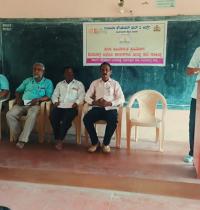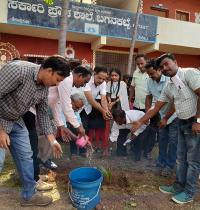Manjunatha A
Project Period: One year and three months
This Foundation Project implemented by IFA engages eighth grade students of the Government High School in Baganakatte, Shivamogga district, with the study of stone inscriptions in Shivamogga and developing a short theatre script on the local stories inscribed on these inscriptions, by connecting it to their Kannada language curriculum. Manjunatha A will be the Coordinator for this project.
Manjunatha A is a theatre practitioner from Shivamogga who has been part of the Shivamogga Repertory as an actor and set designer for the past three years. He has directed many plays for actors at Gudi Cultural Centre in Shikaripura taluk. He has been conducting summer camp for children too in his hometown, and built his own theatre team kalaa sagara to carry on activities mainly on theatre, folk and literature.
Indian inscriptions play an important role in our understanding of history. It captures the political, social, economic, cultural and spiritual facts and figures of specific times. Karnataka is home for many such inscriptions created by prominent dynasties like Kadamba, Ganga, Chalukya, Rastrakuta, and Sevuna. Continuous excavations in Shivamogga, a city of inscriptions, have inspired many scholars to write about them. Recently a stone inscription found in Taalagunda village in Shikaripura taluk is believed to have been written between 455 and 470 AD, which beats the earlier record of the Halmidi inscription as the oldest in Kannada language. This project will engage students in sessions of lectures and workshops on the stories and songs around stone inscriptions in Shivamogga. Following this, students will participate in workshops on the Kannada script, focusing on two major divisions of the language – halegannada (old Kannada) and nadugannada (middle Kannada). Students will discuss different formats of stone inscriptions, and watch a documentary film as well. They will study in detail the three main types of inscriptions – daana shasana,, koota shasana and veeragallu. They will also write a short note on their learnings, and attempt to understand the aesthetics behind the stone sculptures.
In the second half of the project, students will be encouraged to create inscriptions using thermocol and organise an awareness campaign near their school about the importance and preservation of these inscriptions. It is believed that this project will help students to apply their learnings to their Kannada language curriculum and develop a short theatre script which will be performed in school premises.
The outcome of the project will be a performance in the presence of school staff and villagers. The Project Coordinator’s deliverables to IFA with the final report will include photographs and video documentation of the performance and the entire project.
This project suitably addresses the framework of IFA’s Arts Education programme in the manner in which it attempts to connect students and their curriculum to the history of the land they inhabit.
IFA will ensure that the implementation of this project happens in a timely manner and funds expended are accounted for. IFA will also review the progress of the project at midterm and document it through an Implementation Memorandum. After the project is finished and all deliverables are submitted, IFA will put together a Final Evaluation to share with Trustees.



